I know that I really don’t need to promote Kyoto anymore, but there’s one festival you shouldn’t miss if you’re in Japan in July – and that’s the Kyoto Gion Matsuri.
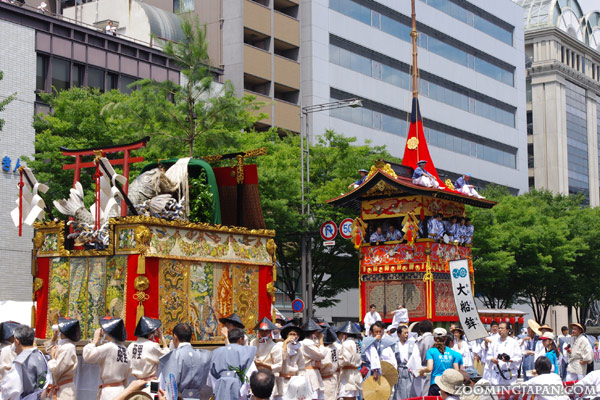
What is the Gion Matsuri?
The Gion Matsuri (祇園祭) which takes place every year in July is one of the largest and most historical festivals in Japan.
Most of the events are held near Kyoto’s Gion district which is also where the festival got its name from. It has a long history and the floats used in the parade are breathtaking.

Access to the Kyoto Gion Matsuri
Depending on the day of your visit the following stations are convenient to access the festival location(s): Shijo, Karasuma, Kawaramachi, Kyoto Shiyakusho-mae and Karasuma-Oike Stations. As the festival takes place throughout the whole month of July, it’s better to ask at the tourist information center inside of Kyoto Station to make sure you know where events are held on a certain day.
So, as you can see it’s called “Gion Matsuri”, but the majority of events is held on the opposite side of Kamogawa River.

When is the Gion Festival?
In fact, the festival takes place throughout the entire month of July. The highlight is the parade on July 17 called “Yamaboko Junko” (山鉾巡行).
In 2014 they resumed another parade after a hiatus of 48 years which is held on July 24th. It’s similar to the one on the 17th, but with fewer and smaller floats.
Not only the parades, but also the three nights before them are absolutely worth attending.
July 16 and 23 are known as Yoiyama (宵山), July 15 and 22 Yoiyoiyama (宵々山) and July 14 and July 21 as Yoiyoiyoiyama (宵々々山). Try to say that three times quickly! ;)

On the days before the parade you can check out the floats from close-up. Tourists can even access some of the floats.
Floats are displayed in their respective districts. This is a great chance to get some photos of all the details of each and every float.
They also put up wooden signs in front of each float explaining the name and some of the float’s features. There’s also an English explanation.

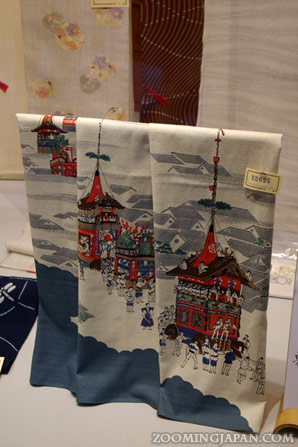
You can observe the participants of the parade who are practicing their performances, for example.
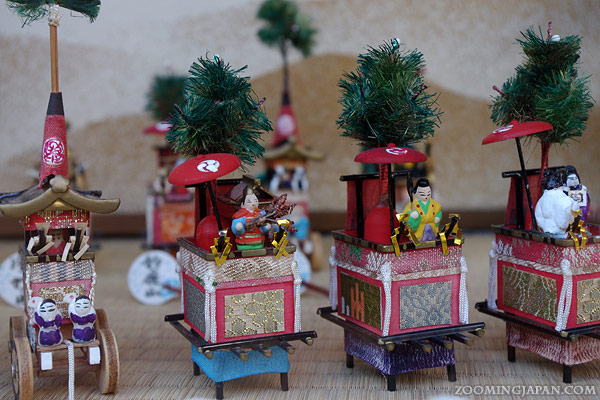
There are food stands, souvenir shops and all sorts of interesting things related to the Gion Matsuri, so take your time and explore!
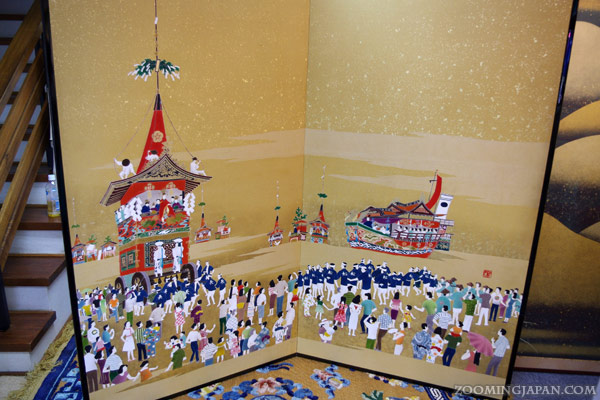
Also, some private houses in the old kimono merchant district open their doors to the public. You get to see some valuable items such as folding screens. It’s a great opportunity to visit and observe traditional Japanese residences of Kyoto.

The really exciting part happens in the evening when streets are closed to traffic from 18:00 – 23:00. There are various food stands and entertaining events to check out. Remember that this only goes for the three nights before the parade!

I’ve just introduced the main events, but there’s something going on almost every single day in July. Here’s a rough schedule for the Gion Matsuri (credit: Wikipedia):
- July 1: Naginata-boko Osendo (From 10:00 at Yasaka Shrine, this year’s sacred page boy visits Yasaka Shrine.)
- July 1-5: Kippuiri (opening ceremony in each participating neighbourhood)
- July 2: Kujitorishiki (lottery to decide parade order)
- July 7: Shrine visit by chigo children of Ayagasaboko
- July 10: Lantern parade and cleansing of the portable shrines
- July 10-13: Setting up the floats (for the parade on July 17th)
- July 12-13: Trial Pulling of Floats
- July 14: Yoiyoiyoiyama (various events)
- July 15: Yoiyoiyama (15:00-18:00: traditional Japanese theater performances at Yasaka Shrine)
- July 16: Yoiyama (from 18:30 at Yasaka Shrine traditional court dance)
- July 17: Yamaboko Junko Parade (main event)
- July 18-20: Setting up of floats (for the parade on July 24th)
- July 21: Yoiyoiyoiyama
- July 22: Yoiyoiyama
- July 23: Yoiyama (e.g. 15:00 at Yasaka Shrine – traditional biwa music)
- July 24: Parade of Yamaboko Floats
- July 25: Kyogen Performance (comical theater performance at 11:00 at Yasaka Shrine)
- July 28: Cleansing of portable shrines (mikoshi-arai) by sacred water from Kamogawa River
- July 31: Nagoshi Summer Purification (Closing Ceremony at Eki Shrine)
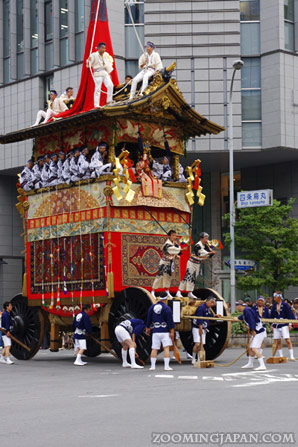

The Festival Floats of Gion Matsuri
There’s a total of 32 floats consisting of two different types called “yama” and “hoko”. The floats are commonly called “Yamaboko” (yama + hoko).
All of them are decorated with beautiful tapestries from Nishijin and from all over the world. On the days before the parade you can get close to the floats and take photos of the beautiful decorations. Many traditional musicians and artists are sitting in the floats – adding to the already heavy weight.

Yama Floats:
The 23 “Yama floats” display scenes from Chinese and Japanese history and mythology. They’re usually decorated with mannequins of famous people, shrine gates, portable shrines or pine trees. An average of 15-25 men have to drag them through the streets:
Weight: 1,200–1,600 kg
Height: ~6 m


Hoko Floats:
You can easily recognize them because of their sheer size. There are 9 “Hoko Floats” and they have a long pole representing the 66 spears used in the original purification ritual (more about that later). The hoko floats are extremely heavy and at least 30-40 men are needed to carry, push or pull them. In order to coordinate the whole team, there are usually two men with fans.


Weight: about 12,000 kg
Height: ~25 m from ground to tip / ~8 m from ground to roof


History of the Gion Festival
The Gion Matsuri is actually one of Japan’s oldest festivals with a history of almost 1200 years.
Just like many other places Kyoto had to deal with all kinds of disasters (quakes, fires, floods, epidemics). In order to keep these away so-called “goryo-e festivals” have been held. The first one of this kind took places in 869 during the Heian period in order to put an end to a series of plagues that happened back then.
Emperor Seiwa wanted special prayers to be recited to ask the god of Yasaka Shrine, Susanoo-no-Mikoto, for help. Additionally, 66 decorated halberds (one for each province of Japan at that time) were set up at Shinsen-en Garden along with portable shrines (mikoshi). This seemed to do the trick. The disasters didn’t haunt Kyoto as often anymore. And whenever there was another plague, they repeated the whole procedure. And so the Gion Festival was born.
In 970 it became a yearly event and – with just a few exceptions – has been continued ever since.

Soon the festival was accompanied by dances, musicians, floats and many other entertaining things. In the beginning it was just a purification ritual. However, in the Kamakura period (1185 – 1333) families of the craft and kimono industry used it as an opportunity to show off their expertise. The floats became bigger and bigger so wheels had to be added. They were too heavy to carry around, they had to be rolled instead.
Thanks to Kyoto’s growing prosperity textiles from other countries were imported and added to the floats from the late 16th century onwards.

Unfortunately the floats were destroyed by fires many times, especially during the Edo period (1600-1868) and the Meiji period (1869-1912). However, the citizens of Kyoto worked hard to rebuild them each time so that the festival could continue with its yearly schedule.
Even nowadays, the floats are kept in special storehouses in the merchant district of Kyoto and the local people take care of them.
Main Event – The Parade “Yamaboko Junko”
The parade on July 17th is without a doubt the highlight of the entire Gion Festival. If you can, I highly recommend visiting on that date.
The parade of the Yamaboko floats is held from 9:00 to 11:30 on July 17th (and July 24th with fewer and smaller floats). They will be dragged from Shijo towards the City Hall in Kyoto. You can see a detailed map of the float procession here.

Every year the families who’re in charge of taking care of the floats will draw lots to decide in what order they will take part in the festival.


The procession is very slow and there are several good spots to view it from. If you want to secure a good spot, you might want to come early enough. Especially the spots around the intersections are popular! However, at some point you might want to walk around. It’s boring to just stay at one spot for the entire time. At least I couldn’t do it.
You also can get paid seating (~ 3180 yen), but you need to reserve in advance. Personally, I don’t see the point unless you cannot stand / walk for a few hours.

One of the most exciting things to experience during the parade is when the big-wheeled “Hoko Floats” have to be turned around at the intersections of Kawaramachi-Shijo, Kawaramachi-Oike and Oike-Shinmachi. This is tricky and requires teamwork, strength and patience.
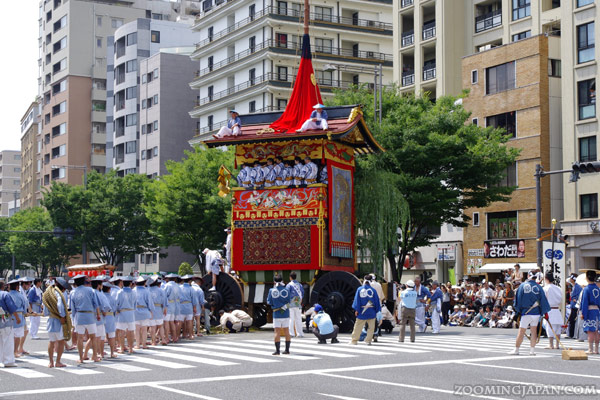
If you’re in Kyoto in July, make sure to check out at least some of the various events. Of course, the parade on the 17th and the 3 nights before that are probably the highlight. Personally, I enjoyed the atmosphere of the night before the festival the most.
But the parade is extremely interesting. You shouldn’t miss it!









The Gion Matsuri is one of the biggest and best summer festivals in Japan, and gives you the chance to see spectacular festival floats, traditional Japanese performances, summer yukata and sample some of Japan’s finest festival food. The hoko floats are truly impressive and are sometimes called ‘mobile art museums’ due to their exquisite craftwork and sculptures. I wish I could visit this year, but not sure with my schedule. I got to enjoy your amazing pictures which might have to be good enough for now.
Exactly. Those “museums” are brilliant. The days before the parade allow us to get close to them and admire all the tiny details. It’s a rare opportunity.
If you ever get to go, I highly recommend staying a few days to experience not only the parade but the few days and nights before it as well.
Yes, I’d love the see yoiyama (festival eve) before the main festival day as well. I bet the atmosphere is amazing with all the food stalls and people in yukata. Getting up close and personal with the ‘mobile art museums’ would be a blast as well :)
It is an amazing atmosphere indeed.
As I did it as a day trip I was so sad to leave in the late evening (around 10 p.m.) to catch the last train back home. Those nights before the parade are long and it’s so lovely to hang out around Kamogawa River. :)
This is a great informative post! The schedule changes a bit every year and it’s hard to find updated info in good English^^
Unfortunately I’ve never made it to the final parade (I always have work!) but I’ve been to preceding evening festivals 3-4 times. It’s so much fun! Not so hot at night and you can wander around (they close off Shijo so it’s foot-traffic only) and eat festival food and wear yukata and see lots of other folks in yukata. There are little tours where you can go inside some of the floats. It’s always soooo crowded but a ton of fun!
I also had to wait a few years until the parade fell on a day off of mine. ^___^
But I’m so glad I got to see it in the end. It’s truly a highlight and I hope you’ll get a chance as well. :)